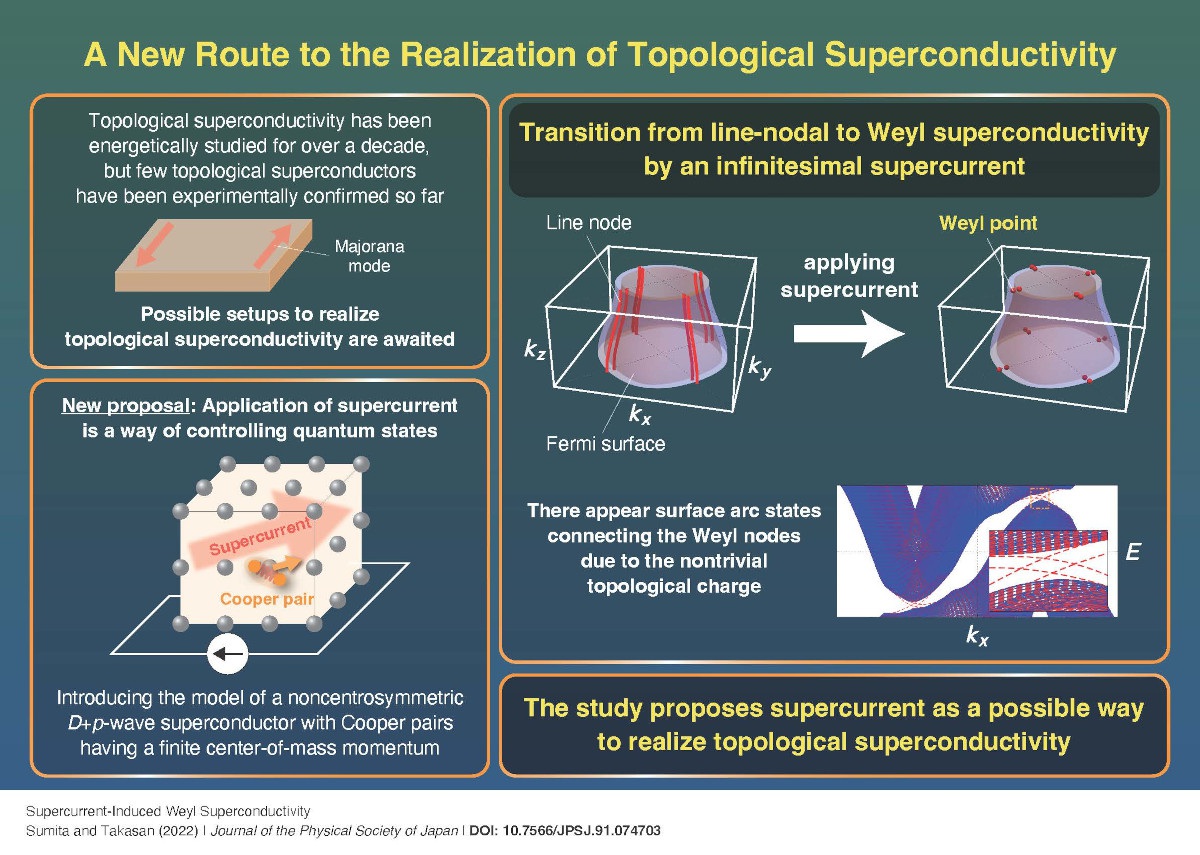A New Route to the Realization of Topological Superconductivity
© The Physical Society of Japan
This article is on
Supercurrent-Induced Weyl Superconductivity
(JPSJ Editors' Choice)
J. Phys. Soc. Jpn. 91, 074703 (2022).
We theoretically suggest that topological Weyl superconductivity can be realized by applying a supercurrent to noncentrosymmetric line-nodal superconductors with spin–orbit coupling.

Superconductivity is a phenomenon observed in certain metals and alloys where electrical resistance vanishes at low temperatures. This property is utilized in superconducting magnets, which are currently used in applications such as MRI machines and maglev railway systems. Superconductivity is considered to originate due to the formation of Cooper pairs of electrons. Cooper pairs can have various shapes (symmetries) depending on the materials. Although the superconductors that are currently used in practical applications have isotropic s-wave symmetry, anisotropic superconductivity has attracted considerable attention in recent studies. For example, high-Tc cuprate superconductors are known to be anisotropic d-wave superconductors hosting line nodes.
Topological superconductivity, which is a kind of anisotropic superconductivity, has been energetically studied for over a decade. Topological superconductors have special surface states called Majorana states, which are theoretically considered to be applicable to quantum computing. However, few superconductors have been experimentally confirmed to possess the topological property so far. Therefore, further research is needed to explore setups that can realize the topological superconductivity.
In this paper, we theoretically demonstrate the usefulness of a supercurrent for controlling the quantum states in superconductors. We introduce a three-dimensional tight-binding model of a tetragonal superconductor in a D+p-wave pairing state with a finite center-of-mass momentum. The results show that topological Weyl superconductivity can be realized by applying an infinitesimal supercurrent to the noncentrosymmetric spin–orbit-coupled superconductors hosting line nodes.
The Weyl superconductivity has point nodes (Weyl points) that are protected by a topological monopole charge. Ordinarily, the structure of the superconducting nodes does not vary greatly since this property is inherent in each superconductor. Nevertheless, the above result indicates that the line-nodal to point-nodal transition occurs due to the cooperation between the applied supercurrent and the spin–orbit coupling arising from the inversion symmetry breaking. This transition drastically changes the topology of the wavefunction in the superconductor. Indeed, the point nodes are Weyl nodes characterized by the monopole charge, and surface arc states connecting the Weyl nodes appear. We also propose CeRhSi3 and CeIrSi3 as candidate superconductors for the supercurrent-induced Weyl superconductivity.
This study proposes the use of supercurrent as a possible method to realize topological superconductivity, which could potentially lead to further developments, such as quantum computing and some electronics/spintronics devices, using the surface states obtained by the controlling method.
(written by S. Sumita on behalf of all authors.)
Supercurrent-Induced Weyl Superconductivity
(JPSJ Editors' Choice)
J. Phys. Soc. Jpn. 91, 074703 (2022).
Share this topic
Fields
Related Articles
-
Cooking in Salt for Ultra-Clean Superconductor UTe2
Superconductivity
2024-4-30
A new crystal growth technique, the molten salt flux liquid transport method, was developed to produce high-quality single crystals of spin-triplet superconductor UTe2. This method is promising for exploring the exotic superconductivity of other materials.
-
Exploring Electronic States in BEDT-TTF Organic Superconductors
Superconductivity
Electronic transport in condensed matter
Magnetic properties in condensed matter
2024-4-24
This review, published in the Journal of the Physical Society of Japan, provides a comprehensive summary of the electronic states observed in BEDT-TTF type organic superconductors, including metal-insulator transitions, Mottness transitions, non-Fermi liquids, quantum spin liquids, and Bose-Einstein condensation.
-
Towards Uncovering the Hidden Order of URu2Si2 Phase Transition
Magnetic properties in condensed matter
Electronic structure and electrical properties of surfaces and nanostructures
2024-1-11
We propose a chiral charge as the hidden order parameter in URu2Si2 and present experiments to detect it by focusing on breakings of mirror and inversion symmetries at the local uranium ion.
-
Possible Origin of High Thermoelectric Power Factor in Ultrathin FeSe: A Two-band Model
Electronic structure and electrical properties of surfaces and nanostructures
Structure and mechanical and thermal properties in condensed matter
Cross-disciplinary physics and related areas of science and technology
2023-12-21
The high thermoelectric power factor observed in ultrathin FeSe can be theoretically explained by a two-band model with chemical potential between upper and lower band bottoms.
-
A New Superconductor Family with Various Magnetic Elements
Superconductivity
Cross-disciplinary physics and related areas of science and technology
Electron states in condensed matter
2023-10-27
A new superconductor family, Sc6MTe2, has been discovered, comprising seven variations with magnetic elements labeled as M. Notably, only a few known superconductor families exist that involve various magnetic elements.
